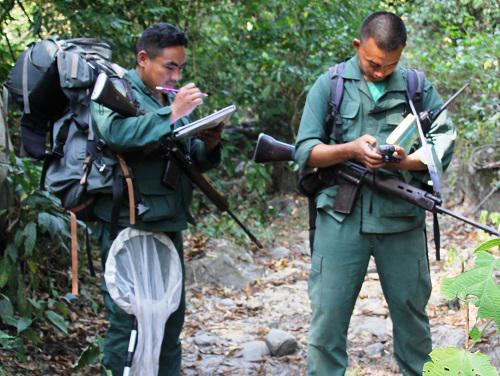Tshering Nidup
Other projects
15 Oct 2018
A Community Education Programme to Curb Direct Pollution of Amphibian Breeding Sites in Eastern Bhutan with Particular Reference to Threatened A. himalayanus
This project has two aims:
1. To determine butterflies diversity along the altitudinal gradient from 108m to 2800m and
2. To create conservation awareness to school students, community heads and religious communities on this species.
/1a8433da0f7439dc32982fd989ff4056.JPG)
Brown awl (Badamia exclamationis).
Butterflies contribute to ecosystem restoration because they supply pollination and a rich source of food for predator such as birds, insects and mice. Increased butterfly populations may indicate an increase in plant diversity and other pollinator groups within restored areas. Butterflies have annual life cycles, requiring that the same conditions be present every year that makes butterflies especially sensitive to climate change, such as pollution and habitat loss, and causes them to be more responsive than birds, plants and other species with longer life cycles

Common Acacia Blue.
The proposed project aims to conduct a systematic survey of butterfly diversity in Royal Manas National Park, collect data on all the species along altitudinal gradient from 108m to 2800m and habitats preferred by various butterfly species using a GPS system. The second aim is to disseminate information and values sharing through awareness campaigns in schools, local and religious communities in and around the project area on conservation, threats, and more importantly the various utility of butterfly diversity in ecosystem. I hope these focal groups will be able to propagate and carry forward the message regarding the importance of butterflies in our ecosystems and the need for their conservation. If I can successfully initiate the butterfly research program, and formulate and disseminate butterfly conservation message to the aforementioned focal groups, it may provide a stepping stone for future butterfly research and conservation programs.

Data collection during sampling.
Capture-photo-release method in a transect line will be adopted. Butterfly net will be used for capturing live butterflies. Butterflies will be safely captured and released at capture sites using safe methods. Identification will be carried out in the field with the help of reference books; when guidebooks are insufficient for proper identification, experts contacted for assistance with photographs, GPS location and a description of habitat type will be sought. Samples of adult butterflies will be preserved in glass box for future reference. The samples will be preserved as and when collected from the sampling sites with GPS coordination.
I have developed my passion and interest with hope to contribute to their conservation in the whole nation in general and in my project area in particular.